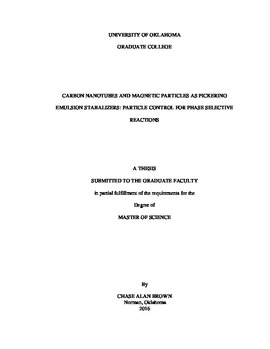| dc.description.abstract | Interest in the use of two phase reaction systems for the production of biofuels and specialty chemicals from biomass has been increasing over the past several years, specifically in circumstances in which the feedstock is comprised of both water soluble and oil soluble components. In addition, these immiscible solvents form stabilized emulsions in the presence of solid particles, which provide larger liquid-liquid interfacial areas. In a two phase reaction system, this increased interfacial area improves the phase transfer of any products reacted at the interface into their favored solvent. In particular, Pickering emulsions stabilized by carbon nanotubes (CNTs) have been shown to be exceptionally stable due to their one dimensional nature, as well as their ability to become highly entangled by their large van der Waals forces. This thesis studies the role of carbon nanotube surface functionality alterations in controlling Pickering emulsion properties. It is found that the behavior of CNTs in Pickering emulsions is similar to that of other solid particles such as silica, although with much higher stability. Liquid biphasic reactors are useful in industry as they allow for a reduction in the amount of capital required if multiple reactions involving different solvents are needed. In hopes to further increase industry interest within these systems, recovery of catalyst via magnetically responsive catalyst supports is studied. This method of recovery may reduce operational cost due to the catalyst loss and environmental issues involved in removing the Pickering particles via filtration. Additionally, we provide some preliminary results that suggest magnetic particles may be of use for controlling reactions in biphasic liquid systems. However, the magnetic support’s mode of operation may be fundamentally different from that of many other two phase stimuli responsive emulsion breaking techniques, as its response is not dictated by surface wetting alterations. We observed that when a hydrophilic catalyst support is forced into a hydrophobic environment within a biphasic reaction system, the catalyst is not as active. As a consequence of this observation, this thesis proposes that the magnetically responsive Pickering emulsion may be of use in applications for which a reversible catalyst deactivation method is required. Discussion of the mechanism for the observation of catalyst inactivity is provided, as it is hypothesized that the particle obtain an adsorbed film of the phase in which they are most soluble. | en_US |
